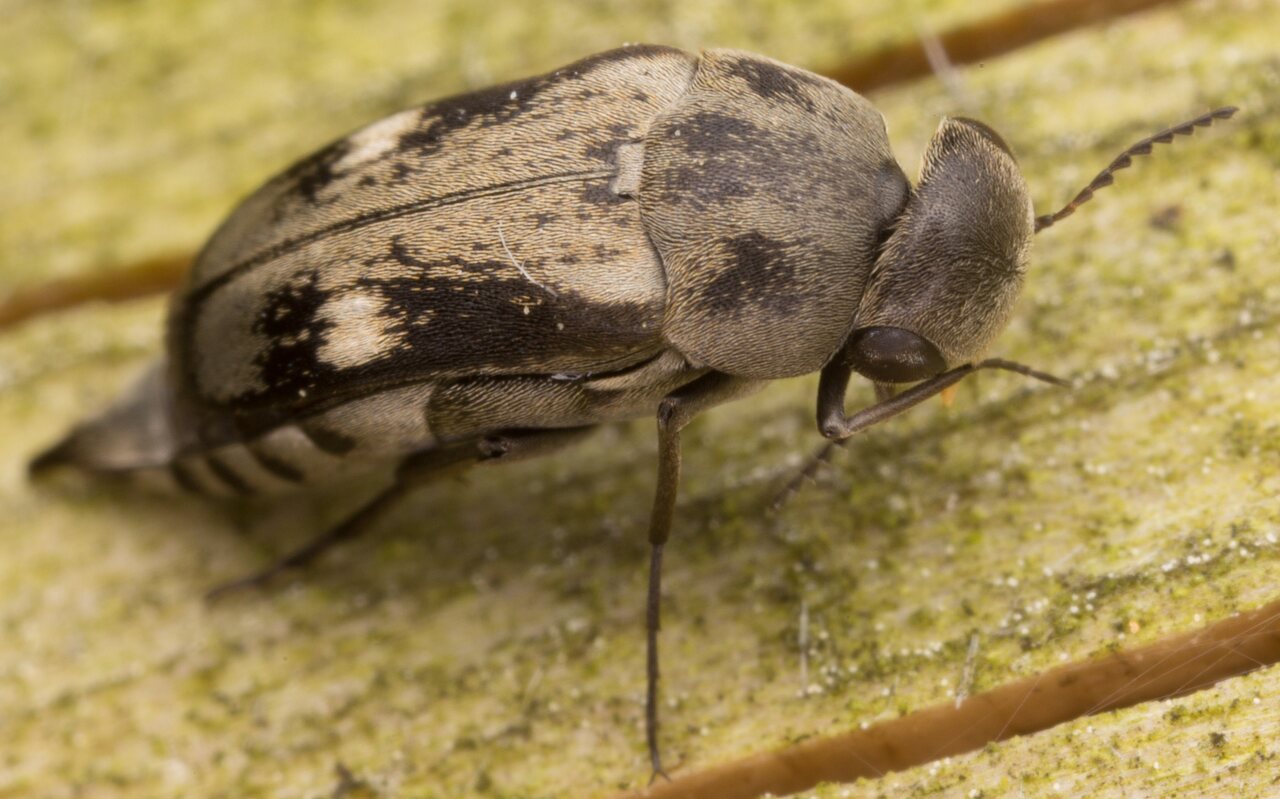
Tomoxia bucephala · dvidėmis dygliavabalis
- Tomoxia biguttata
- Broad-headed Tumbling Beetle
- Brodbille, Toplettet brodbille
- Breitköpfige Stachelkäfer
- haapasyöksykäs
- dvidėmis dygliavabalis
- tvåfläckig tornbagge
- ukbeetles.co.uk/tomoxia-bucephala
- en.wikipedia.org/wiki/Tomoxia_bucephala
- insektarium.net/coleoptera-2/mordellidae-schylikowate/tomoxia-bucephala
- gbif.org/species/4456507
The only member of the genus to occur in Europe, this widespread species is locally common throughout the Western Palaearctic region and extends into Mongolia and eastern Siberia; it is present across Europe from the Mediterranean north to the UK and Fennoscandia and is generally common in warmer southern and western areas, becoming less so in the north and east. Adults are active in hot sunshine from May until August when they may be observed on trunks and fallen timber of a wide range of dead or decaying deciduous trees (on the continent also, but rarely, on conifers), often poplars, willows, birch, beech and horse chestnut but also many others and in our experience hornbeam seems to be favoured over oak and beech, they move very rapidly up and down trunks and take flight instantly they are disturbed. They generally occur in numbers and, given time, several will appear on a single undisturbed trunk, they also visit umbel flowers but mating, which occurs early in the season, usually occurs on trunks or branches. Little is known of the biology but eggs are laid into vacated bark-beetle borings on exposed xylem and larvae develop among decayed and fungus-infested wood in trunks and branches. The species may well be more common than the literature suggests as adults are very elusive, they move very rapidly and are cryptic against dead wood; in bright sun the dorsal pubescence gives them a shimmering metallic appearance which can be very difficult to follow as they move, conversely by being patient and sitting on fallen timber we have had them land on our nets and clothing, during cooler periods they remain in bark crevices etc. and are very difficult to detect.
5.5-8.5mm, entirely black or with the appendages and pygidium a little paler, dorsal surface with pale grey and black pubescence which forms two vague longitudinal stripes on the pronotum and a pale macula or band behind the middle of the elytra. Head widely transverse and evenly convex, truncate across the base and with massive convex and finely pubescent eyes that occupy much of the lateral margin, pubescence even and recumbent, radiating out from centre of the vertex. Antennae inserted laterally in front of the eyes, 11-segmented and slender, weakly serrate from the fifth segment, the terminal segment strongly narrowed before the apex. Pronotum transverse and evenly curved (from above) from a narrow neck to angulate posterior angles, in lateral view the slightly obtuse anterior angles are obvious, basal margin straight medially and strongly curved laterally, the surface evenly convex towards the base and slightly flattened towards the apex. Scutellum transverse with more or less parallel lateral margins and the distal margin concave. Elytra broadest across rounded shoulders and only moderately narrowed to separately rounded apical margins, broadly deflexed at the base but otherwise with very narrow epipleura, surface very densely and often confluently punctured, pubescence uneven, denser around the suture and base and usually with a definite band or spot in the apical half (this varies and specimens occur with all pale or all dark pubescence). Pygidium large, about a third of the elytral length, and truncate or only slightly curved apically. Front and middle legs long and slender, hind legs much more robust, especially the broad and flat femora, hind tibiae with a transverse apical ridge but lacking, or with only very faint, ridges on the external face, and with a single strong apical spur. Tarsi 5-5-4, all segments elongate and in all cases with the basal segment longer than the others, segments not lobed below.
‥
0 comments
Add a comment